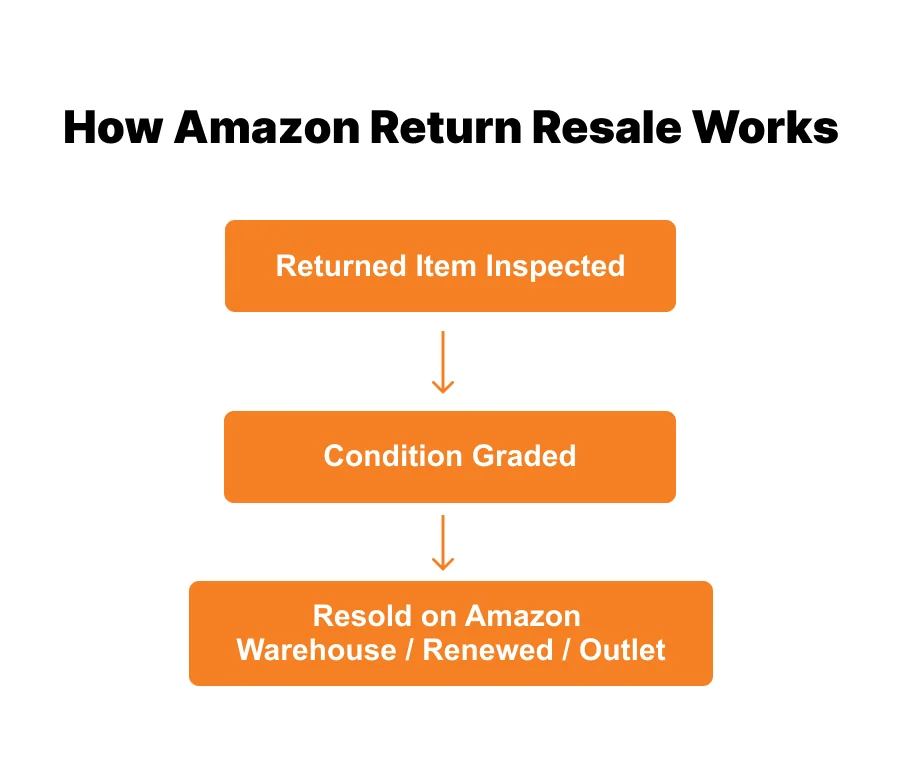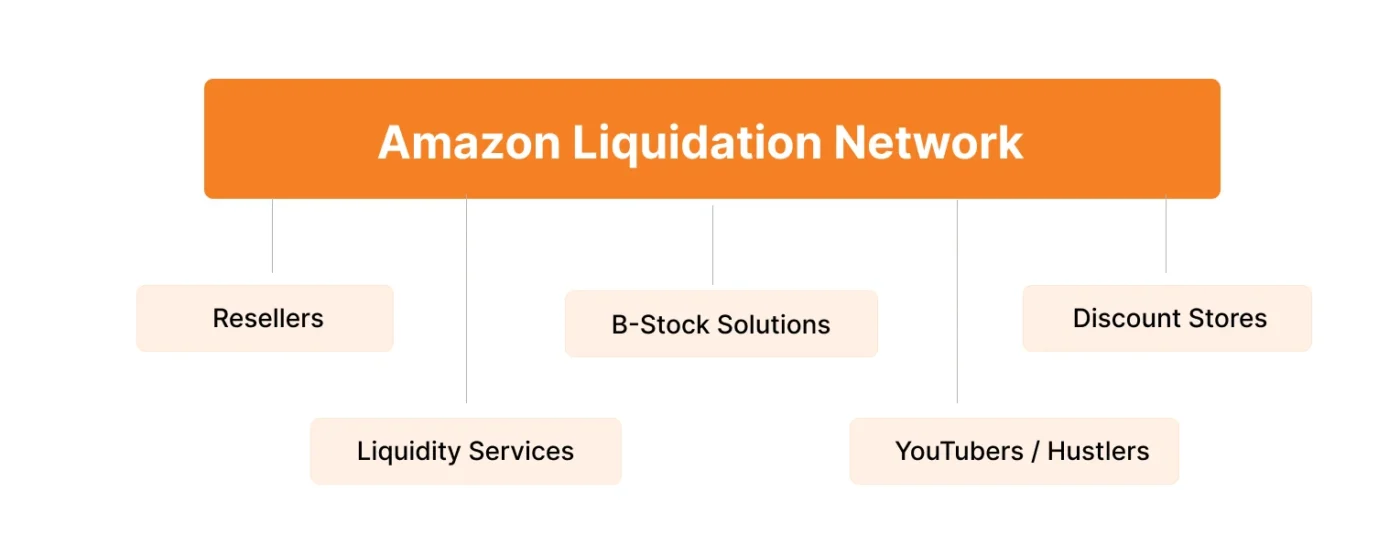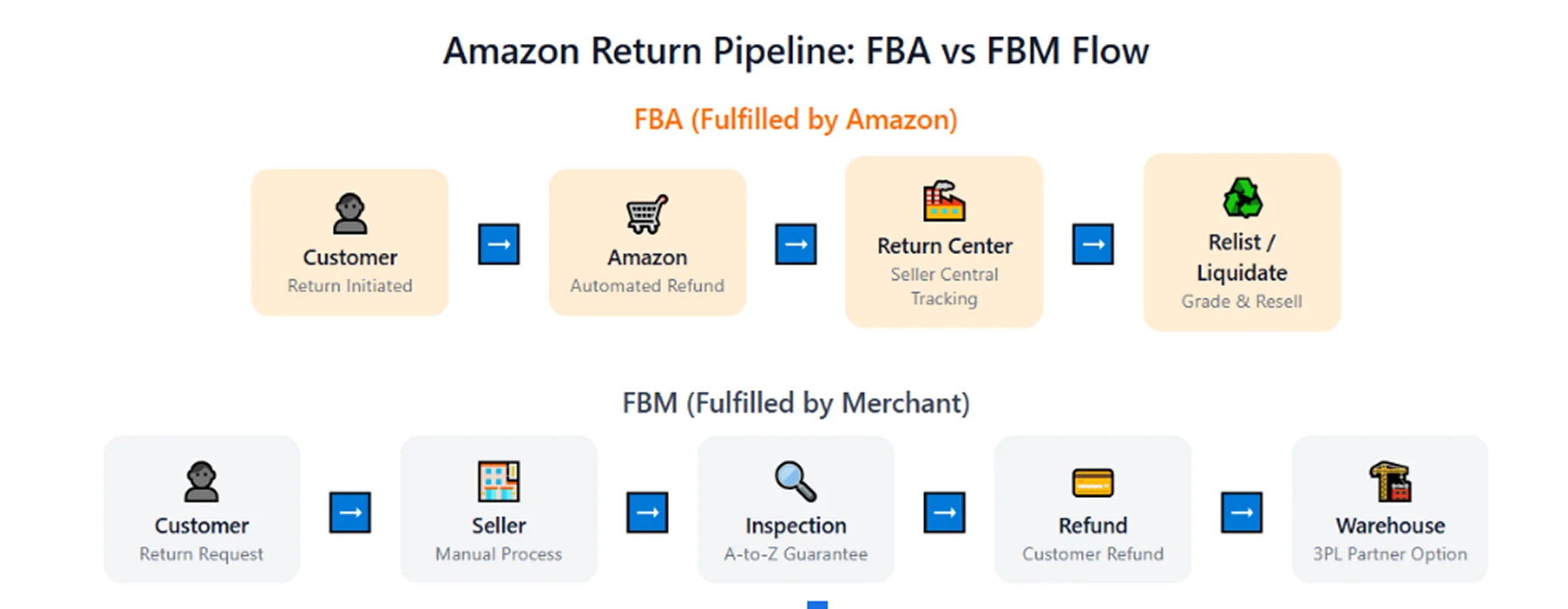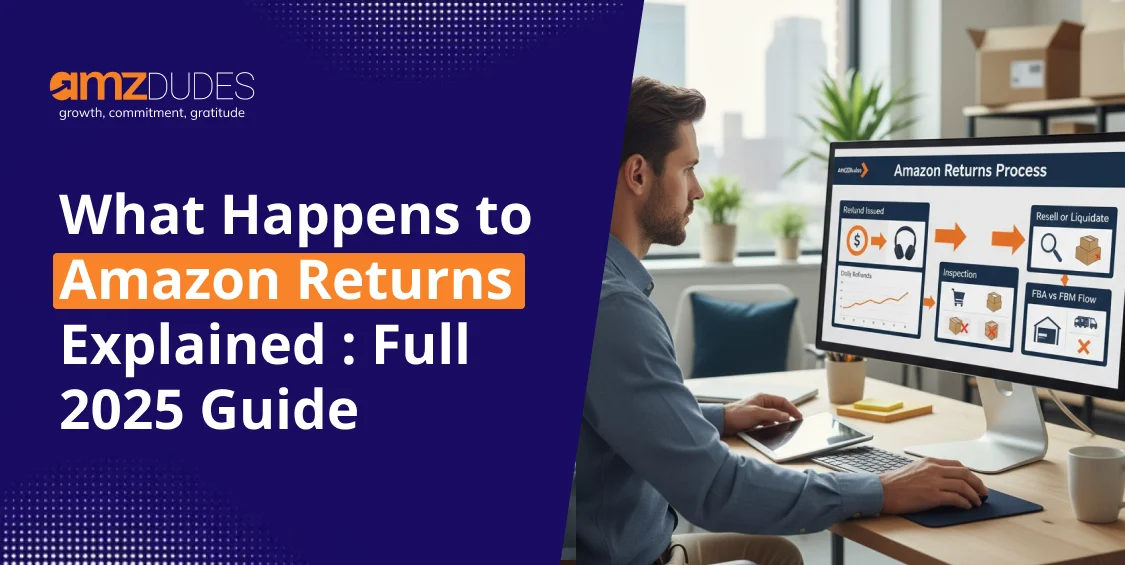Key Takeaways
- Every Amazon return is inspected. Once an item reaches an Amazon return center, it’s checked for authenticity, packaging, and functionality before any next step is decided.
- Good-condition items are resold. Products that pass inspection are repackaged and resold as new or listed under Amazon Warehouse, Renewed, or Outlet programs at discounted prices.
- Unfit items are liquidated or recycled. Returns that can’t be resold are bundled for Amazon Liquidation Auctions or sent to certified recyclers to recover materials and reduce waste.
- Some Amazon returns become waste. Despite sustainability goals, millions of returned items still end up in landfill or energy recovery, contributing to growing Amazon return waste.
- Amazon aims for zero product disposal. Through donation programs, recycling partnerships, and resale channels, Amazon is working to ensure fewer returned items are destroyed and more are reused or repurposed.
The process of returning an online order is now effortless. Even sometimes it is free as well. Some retailers let customers keep the item and still get a refund. Amazon return policy makes it even simpler.
But this convenience of Amazon returns comes with a cost. According to Optoro CEO Tobin Moore, returns create 6 billion pounds of landfill waste and 16 million metric tons of carbon emissions every year. That equals the waste of 3.3 million Americans.
Online purchases are three times more likely to be returned than in-store items. In 2021, buyers sent back $761 billion worth of goods. Over 10% of those returns were fraudulent, says the National Retail Federation.
But what happens to Amazon returns? This guide explains the full journey. It covers how Amazon inspects, resells, liquidates, and recycles returned items. It also shows how the process differs for FBA and FBM sellers.
What Happens to Amazon Returns: Step-by-Step
This step-by-step process will tell you what happens to the items that are returned to Amazon:

Step 1: Inspection and Quality Control of Amazon Returns
Every returned item begins its second life at an Amazon return center. Upon arrival, each package is scanned, unpacked, and assessed for authenticity, condition, and completeness. Products are graded on strict criteria that includes packaging integrity, accessories, and functional performance.
Items in pristine condition are repackaged and reintroduced into active inventory, often indistinguishable from new stock. However, products that show even minor wear or damage move to secondary evaluation channels, where their next destination is determined.
Step 2: Amazon Return Resale
Products that are functional but not “new” enter one of Amazon return resale programs such as Amazon Warehouse, Amazon Renewed, or Amazon Outlet. Each item is listed with a transparent condition grade like Used, Like New or Very Good.

This approach allows Amazon to recapture value, reduce waste, and meet its sustainability commitments. As Raunak Nirmal, former Amazon employee and founder of aggregator Acquco, explained, “If it’s a new product, Amazon would allow it to be resold as new, but it really needs to be in pristine condition for that to happen, and that’s more rare than you would expect.”
So, if you are curious on are Amazon returns resold, yes they are but only when they are in perfect condition.
Step 3: Liquidation and Wholesale Channels
When items aren’t fit for Amazon Return Resale, Amazon turns to bulk liquidation markets. Through Amazon Liquidation Auctions, products are grouped by category or condition and sold to resellers, often by the pallet or truckload.

Liquidity Services and B-Stock Solutions are major partners that auction these lots to entrepreneurs, small businesses, and even YouTube resellers. “For one of our clients one time, we auctioned something like 42 truckloads of floor tiles in one lot,” said B-Stock CEO Howard Rosenberg. “We’ve sold cellphone lots north of a million dollars in a single auction.”
For many, liquidation has become a side business, as YouTuber Hope Allen (HopeScope) described it, “It’s like a fancy version of dumpster diving, but slightly more promising, safer, and more legal.”
Step 4: Recycling and Disposal
When items can’t be resold or repaired, recycling or disposal is the final step. Amazon insists it’s “working toward a goal of zero product disposal” and prioritizes reselling, donating, or recycling over destruction.
Still, according to industry insiders, disposal including “energy recovery” (burning for heat or electricity) remains a reality. As Moore put it, “It’s the easiest thing to do. Some brands do it to protect their image. But when you can sell or repurpose the item, that’s the best outcome for the environment.”
Nike, for example, grinds unsellable shoes into material for running tracks which is an example Amazon hopes to emulate with its recycling partners and donation programs like FBA Donations, which has helped distribute over 67 million items since 2019.
The Amazon Return Process: End-to-End
Following is the Amazon return process explained so that you can better understand what happens to items that are returned to Amazon:

1. Return Initiation by Customer
It all starts when the customer clicks “Return or Replace Item.” A prepaid shipping label or QR code is automatically generated which allows drop-offs at Amazon Lockers, UPS Stores, Whole Foods, or partner hubs due to which no printer, box, or tape is required.
2. Transportation and Tracking
Each of the Amazon returns is assigned a tracking ID and routed through Amazon’s reverse logistics network. It is a vast system of warehouses designed for inbound items rather than outbound sales. UPS predicted a 10% year-over-year increase in returns during the 2021 holiday season, underscoring the growing logistical burden.
3. Arrival and Sorting
Once received the Amazon returns, the system matches each product’s ASIN and order ID to confirm authenticity. Items are then sorted by category and condition from repackaging candidates to liquidation lots or recyclables.
4. Refund and Seller Handling
For FBA sellers, Amazon issues refunds automatically after scanning the return, while FBM sellers must inspect and refund manually. Return reports in Seller Central track reason codes, refund amounts, and item disposition. Sellers can also file SAFE-T claims for ineligible or damaged returns.
The Cost and Complexity Behind Returns
When you think about what happens to Amazon returns, you must know the cost and complexity associated with Amazon returns:
1. Reverse Logistics Overhead
From transport to inspection, sorting, and relabeling, each step of the Amazon return process adds cost. Amazon invests heavily in automation to offset these expenses, but as Iconikal store owner Micah Clausen told CNBC, “Somebody has to pay for that. It’s falling back on either Amazon or the third-party seller, it comes out of their bottom line and inevitably makes prices go higher.”
2. Time Delays & Inventory Management
Amazon returns slow down restocking and distort demand forecasting. Returned products that re-enter FBA inventory must be re-verified before resale, delaying replenishment cycles and cash flow, especially during high-volume seasons like Q4.
3. Condition Disputes
Some buyers return used or incomplete products, and sellers have limited recourse. They can submit SAFE-T claims for reimbursement, but the manual review process adds administrative friction. The National Retail Federation reported that 10.3% of all returns are fraudulent, illustrating how costly misuse of return policies can be.
What Happens to Amazon Returns from Third-Party Sellers (FBA vs FBM)

Here’s what happens to Amazon returns from third-party sellers:
1. FBA (Fulfilled by Amazon)
Under the FBA model, Amazon controls the full Amazon returns pipeline from collection and inspection to relisting or liquidation. Sellers can view every stage in Seller Central, including condition grades and refund reasons.
Refunds are typically automated to maintain customer satisfaction, though sellers pay a processing fee. As Raunak Nirmal explained, Amazon gives sellers up to four options for what to do with returns:
- Return to Seller
- Disposal
- Liquidation
- Invitation-only FBA Grade and Resell.
In the new Grade and Resell program, Amazon grades returned items (New, Very Good, Good, Acceptable) and lists them under Warehouse Deals, Renewed, or Outlet sections which helps in reducing Amazon return waste and improving recovery rates.
2. FBM (Fulfilled by Merchant)
In the FBM model, sellers handle their own returns including receiving, inspecting, and refunding customers directly. While this allows more control, it also brings higher operational costs. Sellers must still comply with Amazon’s A-to-Z Guarantee, which ensures fast refunds and customer satisfaction.
Amazon monitors return handling times closely; delays or poor experiences can harm account health and Buy Box eligibility. Many FBM sellers choose to outsource returns to third-party logistics partners for efficiency.
Impact of Amazon Returns on Sellers and the Marketplace
Returns don’t just impact profit, they influence performance metrics, Buy Box share, and brand trust. High return rates can signal product quality or listing issues, while disputes drain time and resources.
As one seller put it, “You’re forced to decide, recall the inventory to your warehouse, which is expensive, or dispose of it. For most of us, 80% to 90% of the time, disposal is the only viable option.”
This economic reality shows why Amazon introduced new seller-side programs: Liquidation, FBA Donations, and Grade & Resell. Each of them is designed to help sellers recover value without waste.
Amazon’s Push for Sustainable Amazon Returns
After criticism over product destruction in 2021, Amazon publicly committed to achieving “zero product disposal.” In a statement to CNBC, the company emphasized:
“No items are sent to landfill. Our priority is to resell, donate to charitable organizations, or recycle any unsold products. As a last resort, items are sent to energy recovery, but we’re working hard to drive that number down to zero.”
Amazon’s sustainability strategy focuses on three core pillars:
- Resell: Expanding Warehouse Deals, Renewed, and Outlet programs to give products a second life.
- Donate: The FBA Donations initiative, launched in 2019, has already redirected 67 million products to charities via Good360.
- Recycle: Certified recycling for electronics and trade-in programs for Amazon devices.
Still, the broader e-commerce ecosystem faces a behavioral challenge. As Meredith Diggs of Liquidity Services observed, “Wardrobing, where people order multiple sizes just to return extras has become normalized. Most of those returned items don’t go back on the retailer’s shelves.”
Conclusion
Amazon returns reveal the hidden side of e-commerce. Every item sent back triggers a complex process of inspection, grading, resale, liquidation, or recycling. While the system keeps buyers happy, it adds cost, waste, and pressure for sellers.
For brands and third-party sellers, managing returns is not just an operational task. It directly affects profit, inventory flow, and account health. The better you control product quality, listings, and customer experience, the lower your return rate and loss.
Amazon continues to improve its sustainability programs, but success also depends on how sellers adapt. Turning returns into recovered value is the real win. Want to lower your return rate or manage Amazon returns more effectively? Book a free consultation call with AMZDUDES and let our experts help you build a smarter, more profitable return strategy.
FAQs
Q1. What happens to items that are returned to Amazon?
Returned items are inspected, graded, and sent through the Amazon return process. Perfect products are restocked or sold as new, while others are listed under Amazon Warehouse, liquidated in bulk, or recycled if damaged beyond repair.
Q2. What happens when an Amazon return gets stuck in UPS?
If your Amazon return gets stuck in UPS or does not reach the warehouse, contact Amazon Customer Service with your tracking ID. The system tracks packages through the Amazon return policy, and you’ll receive a refund or replacement once it confirms the return delay or loss.
Q3. Are Amazon returns resold?
Yes. Many items from Amazon return resale programs are tested, cleaned, and resold under categories like Amazon Warehouse, Amazon Renewed, or Amazon Outlet. Only products in excellent condition are resold as new, while defective or incomplete items are discounted or recycled.
Q4. Where do Amazon returns go to be resold?
Returned items in good condition go to Amazon Warehouse for discounted resale or to marketplaces like Amazon Liquidation Auctions. These platforms attract resellers, often called “Amazon return hustlers,” who buy pallets of returned items to resell on eBay, Craigslist, or local shops.
Q5. What happens to Amazon return waste?
Items that cannot be reused, resold, or repaired are recycled or sent for energy recovery. Amazon aims to reduce Amazon return waste through donation programs, certified recycling, and sustainability initiatives that keep products out of landfills.




